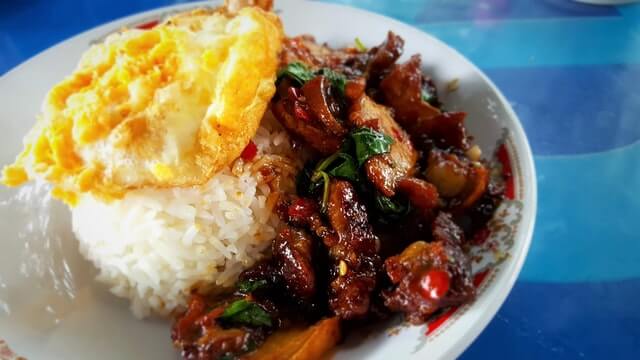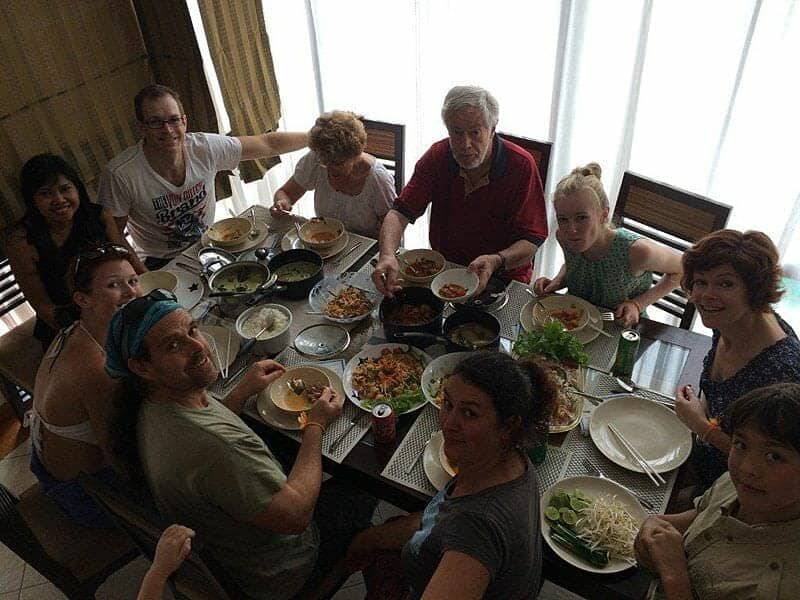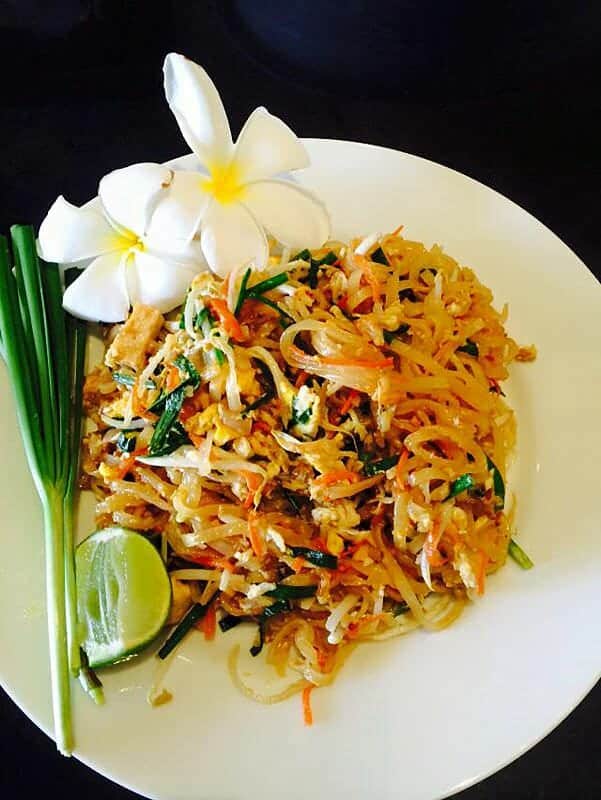Asian food is an attractive option when going out to eat, so often that when your choices boil down to either Chinese or Thai food, the determining factor can often be which one is objectively healthier. At a glance, the two countries’ foods can seem very similar, so figuring out which to eat based on nutritional value and calories can be challenging.
Thai food, on average, is healthier than Chinese food. It’s cooked with significantly fewer oils, and its ingredients are fresher, creating a “lighter” feeling when you finish eating. In comparison, Chinese food is deep-fried more often and can use plenty of preservatives.
Regardless if you’re eating out or ordering in, it’s essential to know the differences between Chinese and Thai food so that you’re informed and know which meal best serves your nutritional and caloric needs.
Is Thai Food or Chinese Food Healthier?
Thai food is culturally made and produced in Thailand, while Chinese food is a cuisine that has its origin in China but has been inspired by many other cultures. While the two cuisines originate from Asian countries, the only similarities between the two are that they include a variation of carbs in their meals—mainly rice and noodles.
In general, Thai food is much healthier than Chinese food. Thai food tends to be well balanced in terms of macronutrients and uses herbs and spices known to have numerous health benefits.
On the other hand, Chinese food isn’t renowned for its numerous health benefits because it tends to be packed with tons of processed additives, oils, sugar, and salt. There are, of course, healthy options, but you have to eat mindfully.
Many Chinese foods are deep-fried as well, which adds a ton of calories to the meal. Deep frying also adds trans fats, which are associated with numerous health problems and increase your risk of developing heart disease, diabetes, and obesity.
Thai vs. Chinese Food: Appetizers
Bite-sized comfort food—or “appetizers” in the West—in Asian cuisines are popular and are always worth mentioning in any discussion of Thai or Chinese food. One appetizer you’ll find in common between Thai and Chinese cuisine is dumplings, and that is where we’ll start our comparison as to which food is generally healthier.
While originally a Chinese dish, dumplings have long since made their debut in Thailand culture, and they’ve long since made the appetizer with their own unique spin. (Despite being universally referred to as “dumplings” in the West, Chinese dumplings are called Shuji Jao, and Thailand dumplings are called Khanom Jeeb.)
| Thai Dumplings | Chinese Dumplings | |
| Wrapper | Thailand dumplings are traditionally made from wonton wrappers, which are thin sheets of dough that can be cooked in various ways. | While Chinese dumplings can be made from the same Wonton wrappers, you’ll usually find that they’re organically made from all-purpose flour. |
| Filling | Thai style dumplings are much like Chinese dumplings in the sense that they can be filled with just about anything you could imagine. However, typically the insides are exclusively filled with pork and shrimp. | Chinese dumplings usually have meat and vegetables on the inside, and biting into them, you’ll notice a soup-like texture. |
| Sauce | Like many other Thailand dishes, it’s the dumpling sauce that really distinguishes itself from other Asian variants. Thailand dumplings use fish sauce like other meals, and it really adds to the sweet and sour taste. | Chinese dumplings are more inclined to use soy sauce, which adds a salty flavor to the appetizer. |
| Cooking Method | Dumplings can be boiled or deep-fried. | Dumplings can be boiled or deep-fried. |
It’s hard to say whether Thai or Chinese dumplings are healthier; however, because you have the option of customizing the fillings of your dumplings and opting for boiled dumplings instead of deep-fried ones, you certainly have more control over the calories with your choice.
Thai vs. Chinese Food: Rice-Based Dishes
Rice has been a popular inclusion to Asian cuisines for ages and has many diverse variations. Amongst those variations are Thai and Chinese fried rice. Thai fried rice and Chinese fried rice are inherently very similar dishes, but some ingredient choices make the two dishes unique and separate.
| Thai Fried Rice | Chinese Fried Rice | |
| Rice | Thai fried rice is cooked with jasmine rice, giving it a very distinctive flavor. | Chinese fried rice is typically made with long grain rice. |
| Protein | It’s not uncommon to find chicken, as well as shrimp and fish. Scrambled eggs can also be found in Thai fried rice. | Chinese fried rice may also contain chicken, shrimp, fish, and scrambled eggs. However, it is more apt to have barbeques, pork, and shrimp than Thai fried rice. |
| Sauce | Thai fried rice is made with fish sauce, or nam pla, which creates a salty, sweet, and spicy flavor. | Chinese fried rice is typically partnered with soy sauce. It’s also made with chicken stock, an ingredient responsible for the yellowish color Chinese fried rice gets. |
Both types of rice used in Thai and Chinese fried rice are equivalent nutritionally, as they’ve both been stripped of their nutritional value for being refined carbohydrates. However, you wouldn’t be wrong to avoid eating more than the recommended serving size. Alternatively, you can substitute fried rice for brown rice if you’re interested in the nutritional content a carbohydrate source can provide you.
In general, there’s more of a nutritional benefit to eating Thai fried rice over Chinese fried rice because the individual ingredients used are better for you. If you’re watching your sodium levels, the fish sauce in Thai food is better for you than the soy sauce used in Chinese food.
Thai vs. Chinese Food: Noodle-Based Dishes
Two comparable noodle-based dishes are Pad Thai and Lo Mein, Thai and Chinese dishes, respectively. Pad Thai is made out of flat vermicelli noodles and stir-fried with various other ingredients. Lo Mein is typically made with round noodles.
The two dishes taste somewhat differently as well, with Pad Thai typically possessing a sweet and sour taste due to the sauce it’s tossed in. Lo Mein is not as sweet as Pad Thai, and more savory because of the soy sauce, oyster sauce, garlic, and ginger used in the dish. It’s tossed in a sesame oil base.
The nutritional value and calorie count of the meals can vary based on how each item is prepared. Based on these noodle dishes’ traditional ingredients, Pad Thai has 357 calories per serving, while Lo Mein has 310 calories per serving.
Pad Thai tends to be less healthy than Lo Mein because the sauces involved are loaded with sugar. Lo Mein typically has more vegetables loaded in, which ultimately reduces the number of potential calories in the meal.
Healthy Thai Food Options
Thailand tends to enjoy a palette full of seafood, vegetables, and meats that are always accompanied by a healthy serving of herbs and spices. While Western variations of Thai restaurants try to honor Thai food’s aesthetic, serving sizes can be much larger.
Thai food is characterized by its lightness and how it has strong aromatic components. Thai foods tend to be quite spicy, in addition to the plethora of other flavors that Thai meals offer. Thai food places emphasis on its options of fresh ingredients that are constantly included in each meal.
Healthy Thai Food Ingredients
Here are some of the common ingredients in Thai Food that makes it overall a healthy option for casual consumption:
Overall, Thai food is a relatively healthy option in addition to the numerous benefits that the individual ingredients bring to the table for your needs. Thai food offers a balanced diet, and a typical meal contains a healthy blend of proteins, fats, and carbohydrates.
Thai food also doesn’t shy away from including non-starchy vegetables in its meals, offering you a whole host of health benefits loaded with fiber amongst other properties contributing to wellness and good digestion.
Healthy Thai Foods to Order
Thai cuisine has plenty of healthy, lean, and nutritious options for your consumption. Here are a few:
Unhealthy Thai Foods to Avoid
Just like all foods, while eating Thai food can generally be a healthy experience, depending on what you include in your dish, the meal can go from healthy to unhealthy very quickly.
While Thai food promotes a balanced, nutritious meal for consumers, many popular meals in Western Thai food can be unhealthy. For instance, the Pad Thai usually includes large portions of white or fried rice and rice noodles.
Not all carbs are equally nutritious, and these would fall into the category of being a refined carbohydrate. Refined carbs tend to have the majority, if not all, of their fiber removed, which is the main nutritious benefit of consuming carbs. Refined carbs are considered empty calories for this very reason.
With that said, if you opt for a dinner portion, try to avoid the rice if a healthy, nutritious meal is what you’re looking for.
Healthy Chinese Food Options
Chinese food is definitely delicious and fun to indulge in, but it’s almost inarguable how unhealthy it is for you, especially in comparison to Thai food. It’s worth noting that Chinese food isn’t inherently unhealthy, but it is harder to find lean equivalents in Chinese foods, especially in the West.
Unhealthy Chinese Food Ingredients
Chinese food tends to be liberal in its usage of rice, noodles, and other refined carbs. There’s a distinct attempt to bring out more of the fats with an excess of meats, greats, and oils. Chinese foods also tend to be quite liberal in the salt, which always has the potential to raise your blood pressure and increase your chances of developing other conditions.
Sauces in Chinese food tend to be more optional than Thai foods, and preserved ingredients are frequently used in preparing the meals, which serves as a large distinguisher between the two cuisines. Chinese food is also habitually deep-fried, which has poor consequences on the body.
While healthier options indeed do exist, Chinese food is also liberal in its usage of MSG. MSG stands for Monosodium glutamate and is a controversial additive that can be found in many Chinese dishes to enhance the flavor. It’s been linked to headaches, asthma, and weight gain, despite there being little evidence to support this.
It should be noted that some people may be sensitive to the effects of MSG, so if you believe you’re one of those people, don’t hesitate to ask your local Chinese restaurants about their inclusion of MSG in their meals.
Healthy Chinese Food Alternatives
While Chinese food is typically unhealthy, you certainly have some options if you’re trying to eat it and remain healthy. Here’s a quick list of foods you can safely eat without jeopardizing your wellbeing:
Final Thoughts
While there are some variances in individual meals, Thai food is overall the healthier choice if you’re looking to eat some Asian food. It’s typically lighter, and its ingredients are fresh and healthier for the body.
In contrast, Chinese food isn’t shy about its preservatives usage, nor its frequent deep frying in meals. Additionally, Chinese food uses many oils to cook, adding to the overall calories in the meal.
This content was originally published here.



